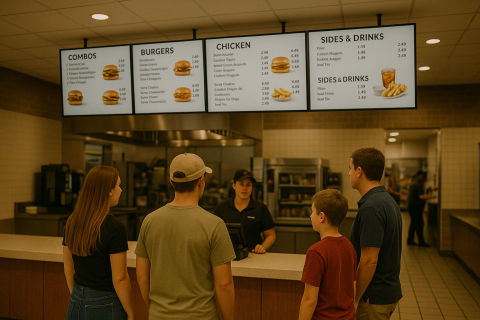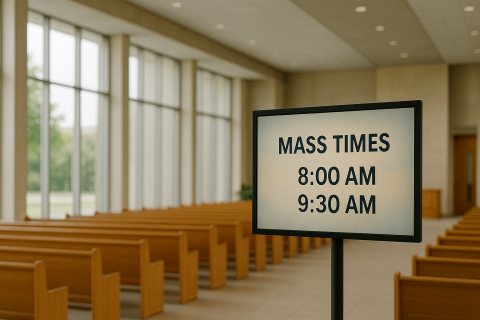Remote digital signage has emerged as a powerful tool for businesses to capture attention and convey messages effectively. With the advent of remote digital signage software and digital signage remote management features, managing and updating digital displays has become easier and more efficient than ever. In this article, we’ll explore what digital signage is, how it was managed in the past, and how remote management capabilities have changed team workflows. We’ll also delve into key features of remote digital signage software and offer tips on getting the most out of these tools, in particular with Screenly’s cloud-based digital signage solution.
What is digital signage?
Digital signage refers to the use of digital displays—such as LCD, LED, or projection screens—to present content to prospective customers, employees, or passing foot traffic. Digital signs are commonly found in retail stores, restaurants, corporate offices, and public spaces. They serve various purposes, from advertising and brand promotion to providing real-time updates and notifications. Digital signage content can be customized and scheduled to target specific audiences at optimal times, making it a versatile communication medium.
How digital signs were managed in the past
In the early days of digital signage systems, managing content was a manual and time-consuming process. Teams had to physically visit each digital sign to update its content. This often involved using USB drives to transfer media files and connecting keyboards to navigate the player interface. For businesses with multiple screens or in multiple locations, this approach was extremely labor-intensive and inefficient. The lack of digital signage remote management software and remote control capabilities meant that updating content across multiple digital signs was a logistical challenge, leading to outdated displays and missed opportunities.
Using remote digital signage software to improve workflows
The introduction of remote digital signage software has transformed how businesses manage their digital displays. With cloud-based solutions, teams can now update and schedule digital signage content from anywhere, at any time. Remote media digital signage tools allow for real-time content updates and ensure that all screens display up-to-date content in just a few clicks. By centralizing content management, businesses can more easily manage multiple screens across multiple locations. Importantly, remote management enables teams to focus on creating fresh and engaging digital signage content rather than dealing with the logistics of manual updates.
Key features for remote digital signage software
When selecting a remote digital signage solution, it’s important to consider key features that will enhance your operations. Cloud-based management allows you to access and control your digital signage content from any device with an internet connection, giving you the flexibility to manage your displays remotely. Content scheduling enables you to plan and schedule content in advance for specific times and dates. This ensures that your audience sees the right message at the right time without the user having to be involved in content changes throughout the week or month.
Another important feature is screen group labeling. Screen labeling helps you organize screens into groups, allowing you to manage multiple digital displays simultaneously. This is particularly useful for businesses with multiple screens in different locations, as it simplifies the process of deploying content across various related digital signage systems. Instead of updating one screen at a time, you can update a group of tagged realted screens in the same workflow.
Supporting various content types is essential for engaging your audience. Ensure that the software supports images, videos, web pages, and even social media feeds. This versatility allows you to create dynamic and interactive digital signage content that captures attention. Additionally, remote management and monitoring features enable you to keep track of your digital signage systems’ health and performance from afar, ensuring that your digital displays are always functioning optimally and that you are alerted when a screen needs troubleshooting.
How to get the most out of digital signage software
To maximize the benefits of your digital signage software, it’s important to plan your content strategy carefully. Understanding your audience and tailoring your digital signage content to engage them effectively is key. Using high-quality media, such as compelling images and videos, can capture attention and convey your message more effectively. Incorporating social media integration can also increase engagement by displaying live social media feeds, keeping your content fresh and interactive.
Scheduling content wisely enhances the effectiveness of your digital signs. By taking advantage of content scheduling features, you can display relevant information at the right times, ensuring that your messaging aligns with your audience’s needs and expectations. Monitoring the performance of your content through analytics helps you understand which messages resonate most with your audience, allowing you to adjust your strategy accordingly.
How to best use digital signage software as a team
Effective collaboration is crucial when managing digital signage as a team. Assigning roles and permissions using the software’s user management features helps delegate tasks and control access levels. This ensures that team members can focus on their specific responsibilities without overstepping into areas outside their purview. Maintaining a shared content library allows team members to access and use approved content, streamlining the content creation process and ensuring consistency across your digital displays.
Regular communication among team members keeps everyone informed about content updates, schedules, and any changes in strategy, ensuring that the team operates cohesively. Providing training for team members on how to use the digital signage software effectively can maximize productivity and reduce errors. By fostering a collaborative environment, your team can manage your digital signage more efficiently and create a cohesive brand message across all your digital signs.
How to get started with Screenly
If you’re ready to transform your digital signage management, Screenly offers a comprehensive remote digital signage solution that’s easy to use and packed with powerful features. With Screenly, you can manage your digital signage remotely, schedule content, and monitor your screens in real time. Screenly’s digital signage software supports various content types, including images, videos, and live web pages, allowing you to create dynamic and engaging displays. Through Edge Apps, Screenly also offers customizable digital signage applications that allow you to display content from your favorite business and design software.
Getting started with Screenly is simple. Sign up for a free 30-day trial of Screenly’s digital signage software to explore all the features and see how it can benefit your business. With Screenly’s cloud-based digital signage solution, you can start managing your digital displays across multiple screens and multiple locations with ease.





